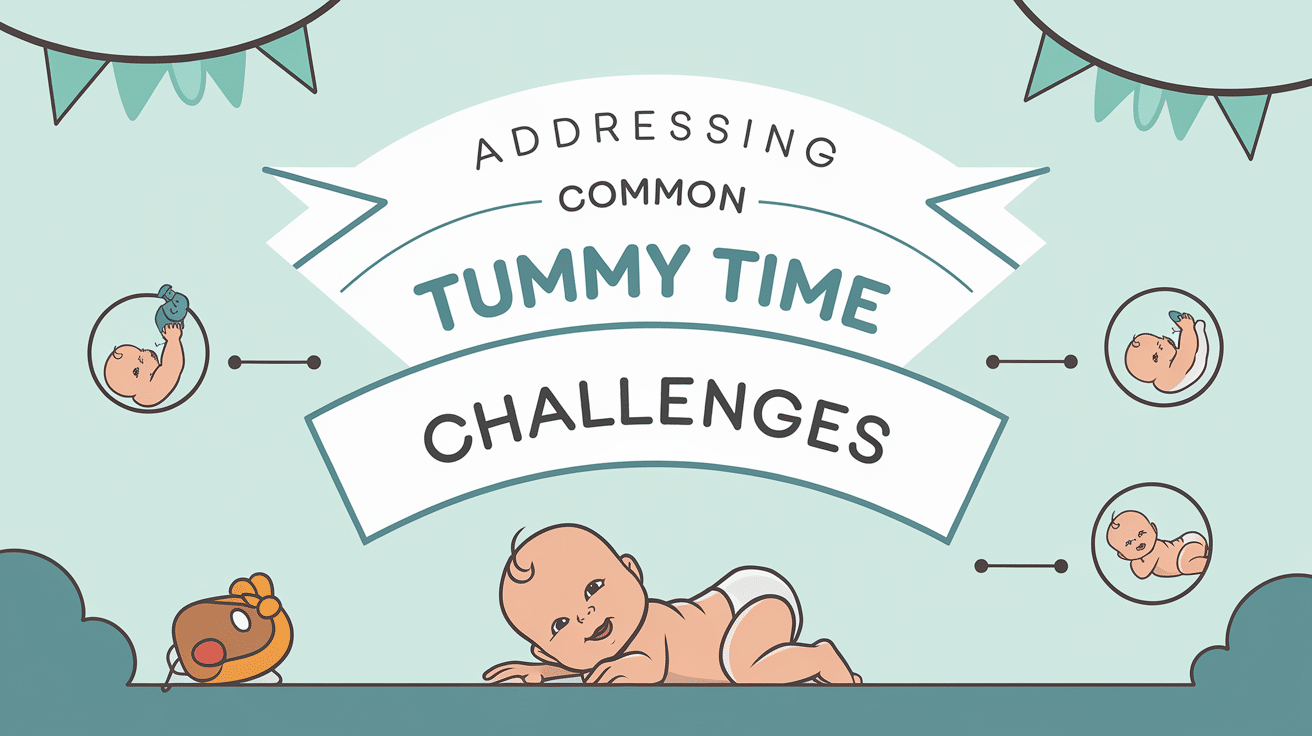
Did you know that babies who get regular tummy time are often quicker to reach critical motor milestones like crawling and sitting up?
This essential activity isn’t just about following pediatric recommendations—it’s about setting your little one up for developmental success. Tummy time strengthens your baby’s neck, shoulder, and core muscles while preventing flat spots on their head.
As your baby grows, you’ll witness remarkable progress during these belly-down sessions, from early head lifts to pre-crawling movements.
Understanding what to expect at each stage helps you provide the right support and know when your baby is thriving.
Ready to uncover what tummy time success looks like month by month? Let’s analyze the key milestones that mark your baby’s incredible physical development progress.
What is Tummy Time, and Why It Matters?

Tummy Time is a crucial, supervised activity where infants are placed on their stomachs while awake.
It strengthens their neck, shoulder, and arm muscles while fostering motor skill development. This practice also helps prevent head flattening and enhances sensory exploration.
Regular Tummy Time supports healthy physical growth by encouraging milestones like rolling, reaching, and sitting.
These foundational skills pave the way for crawling and walking, contributing to a baby’s long-term health and development.
Parents should incorporate Tummy Time early on in a safe and engaging environment. It builds physical strength and coordination and stimulates curiosity and interactive play.
Consistent sessions improve posture and balance, helping babies develop better movement control. Additionally, it boosts self-esteem and curiosity, laying the groundwork for confident, active development.
Tummy Time Milestones by Months

Tummy Time milestones vary by month, helping babies develop essential motor skills like head control, rolling, and crawling.
This table outlines key physical progressions from birth to 12 months, showing how strength and coordination improve. Tracking these milestones ensures a baby is developing appropriately and gaining foundational movement skills.
| Aspect | 0-1 Month | 2-3 Months | 4-5 Months | 6-7 Months | 8-9 Months | 10-12 Months |
|---|---|---|---|---|---|---|
| Head Control | Turns head slightly | Lifts head briefly | Holds head up steadily | Strong head control | Stable head control | Fully stable |
| Arm Strength | Minimal movement | Starts pushing up | Pushes up with arms | Pushes up fully | Strong push-ups | Strong arm support |
| Rolling Over | Not yet | Not yet | May roll front to back | Rolls both ways | Active rolling | Confident rolling |
| Pushing Up | Limited push-up | Begins pushing up on arms | More control in push-ups | Pushes up with elbows straight | Pushes up to hands and knees | Pushes up easily |
| Reaching & Grasping | No reaching | Attempts reaching | Reaches for objects | Grasps and transfers objects | Improved hand coordination | Fine motor skill refinement |
| Sitting Readiness | Not yet | Not yet | Begins sitting with support | Sits without support | Moves into a sitting position | Transitions between positions |
| Crawling Prep | No crawling prep | Limited leg kicking | Shows leg strength | Rocks on hands and knees | Begins crawling | Crawling or starting to stand |
How to Support Your Baby’s Tummy Time Development?

Ensuring a positive Tummy Time experience involves knowing the do’s and don’ts to support healthy development. Simple tips can help make sessions more comfortable and enjoyable for your baby.
Activities like toys and interactive play can encourage movement and build strength. Best practices can make Tummy Time fun, beneficial, and a key part of daily routines.
Do’s and Don’t’s of Tummy Time
The Do’s:
- Start early – Introduce Tummy Time for short sessions from the first few weeks.
- Use a soft, safe surface – A play mat or blanket provides comfort and support.
- Engage with your baby – Use toys, mirrors, and eye contact to make it fun.
- Practice daily – Aim for multiple short sessions throughout the day.
- Encourage movement – Help your baby push up by placing toys within reach.
The Don’ts:
- Don’t force it – If your baby is fussy, try again later in a calmer setting.
- Avoid placing baby on a full stomach – Wait at least 30 minutes after feeding.
- Don’t leave your baby unsupervised – Always stay close for safety.
- Avoid hard surfaces – Ensure a cushioned, non-slippery area for comfort.
- Don’t skip Tummy Time – Regular practice is crucial for motor skill development.
Tummy Time Tips for Success
Start with short sessions, around 1-2 minutes, and gradually increase as your baby builds strength. Make Tummy Time part of daily routines, such as after naps or diaper changes, to create consistency.
Use toys, mirrors, or colorful objects to grab your baby’s attention and encourage movement. Laying on the floor at eye level and talking to your baby can provide comfort and motivation. If your baby resists, try different positions, like placing them on your chest or across your lap for a gentler approach. Ensure a soft, supportive surface for comfort and safety.
Be patient and make it fun—turn it into a bonding experience with playful interactions, songs, and gentle encouragement to help your baby enjoy Tummy Time.
How Can I Make Tummy Time More Engaging for My Baby?
These pointers provide simple ways to make Tummy Time more engaging and enjoyable for your baby and help make Tummy Time more comfortable both for the mother and baby.
- Use colorful toys, mirrors, or soft books to grab attention and encourage movement.
- Talk, sing, or make funny faces at eye level to keep your baby engaged.
- Introduce textures with a soft blanket, play mat, or tummy-time pillow for added interest.
- Change locations by trying Tummy Time near a window or outdoors for new visual stimulation.
- Try different positions, like placing your baby on your chest or across your lap for comfort.
- Use a rolled towel under their chest for extra support if needed.
- Keep sessions short but frequent to make Tummy Time a fun bonding experience.
- Celebrate small achievements to boost your baby’s confidence and enjoyment.
How Does Tummy Time Help With Other Developmental Milestones?

Tummy Time strengthens neck, shoulder, and arm muscles, essential for motor development. It helps babies develop head control, a crucial skill for sitting up, rolling over, and eventually crawling.
By encouraging weight-bearing through the arms, Tummy Time improves coordination and prepares babies for pushing up, reaching, and grasping.
These movements support hand-eye coordination, fine motor skills, and overall physical development.
Spending time on their tummy also enhances balance and posture, making transitions to sitting, crawling, and standing smoother.
Additionally, it promotes sensory inquiry, spatial awareness, and visual tracking as babies observe their surroundings.
Regular Tummy Time lays the foundation for future gross motor skills, helping babies gain confidence in movement. These early milestones are key to independent mobility and overall growth.
Addressing Common Tummy Time Challenges

Some babies resist Tummy Time due to discomfort or unfamiliarity. Start with short sessions and gradually increase the duration.
If fussiness occurs, place your baby on your chest or lap first. A rolled towel under their chest can add support and comfort. In any deteriorating scenario, consult a doctor.
Ensure a soft surface and use toys, mirrors, or music to keep them engaged. Placing toys slightly out of reach can encourage movement.
With consistency, patience, and playful interaction, your baby will gradually enjoy Tummy Time and gain its benefits.
When to Consult a Healthcare Provider?

It may indicate an underlying issue if your baby consistently dislikes Tummy Time and shows no improvement despite adjustments. Babies struggling to lift their heads by 3 months or with limited arm movement may need evaluation.
Lack of rolling by 6 months, difficulty pushing up, or overall muscle weakness could indicate developmental delays. Consult a pediatrician if your baby seems stiff or floppy during Tummy Time.
Early intervention can help address concerns and support healthy motor development. If you’re unsure about your baby’s progress, seeking professional advice ensures they receive the right guidance and care.
Summing It Up
Tummy time is a crucial practice that strengthens your baby’s neck, shoulders, and core muscles during their first year. These belly-down sessions develop the essential strength for sitting, crawling, and walking.
Each month brings exciting new achievements as your little one progresses from wobbly attempts to confident movements.
Understanding these developmental stages helps you provide appropriate challenges and support when needed. Tracking these milestones ensures proper development and creates wonderful opportunities for bonding with your baby.
If you’re a first-time parent or an experienced caregiver, having a clear roadmap of expectations makes tummy time more rewarding for everyone involved.
Get ready to unlock your baby’s physical potential—one belly-down session at a time!
